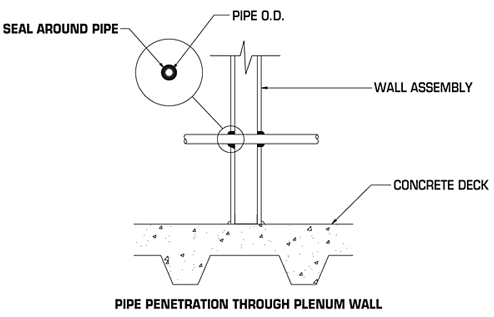Technologies for Energy Efficiency
Overhead systems force cool air from above mixing the entire space to the set thermostat temperature. Therefore, the entire heat load of the space must be used to calculate the CFM requirements. In a UFAD system air is delivered from below with very little mixing so only the load affecting the 6 foot occupied zone is used to calculate for the system CFM requirements. This reduction in load maintains similar CFM requirements for both systems.
In a ducted mechanical system, forced air is provided through diminishing ductwork. As a duct gets smaller, the force needed to push the air is larger, typically requiring significantly more pressure. One of the greatest savings of a raised floor system is that the large fans and motors to distribute forced air can be reduced in size and power.
Additional savings are achieved through the use of underfloor air distribution, particularly in moderate climates as the air provided to the plenum from the central HVAC system is delivered at 63 to 65 degrees allowing more fresh air to be introduced into the system through longer economizer operation. Overhead systems provide air at a constant 55 degrees and that 8 degree difference adds to the savings in the use of the chiller for air conditioning.
The importance of early integration and design details
The integrity of the plenum "is one of the most important aspects of designing, contructing and maintaining an underfloor air delivery (UFAD) system."18 An integrated approach to the design of an UFAD system will include these stages of the design and construction cycle:
- Design:Specifications and performance requirements for plenum sealing integrity should be included in all divisions of the CSI (Constuction Specifications Institute) specification. Drawings detailing the construction requirements for the UFAD plenum should be provided to the contractor.
- Pre-bid Meetings should be required to inform all subcontractors of plenum sealing including the requirements for mock-up construction.
- Pre-construction Meetings should be specified to reaffirm the plenum sealing requirements to each awarded sub-contractor.
- Mock-up: Specify the construction and testing of a mock-up that includes all actual building conditions and components that penetrate walls, floors and in particular electrical and mechanical closet areas.
- Quality Inspection: Specify the use of a commissioning agent to audit the construction process, perform air leakage testing on the mock-up and final installation and provided detailed reporting to the General Contractor that the UFAD system follows the specified Requirements.19
Manufacturers will provide guidelines and assistance with specifications and testing criteria in order to assure the maximum performance and integration of an UFAD into the building.
Meeting standards
The Ceilings & Interior Systems Construction Association (CISCA) recommends testing procedures for access flooring. These tests include structural loading, impact, and air leakage through panel seams. As the market for raised floors becomes increasingly global many manufacturers are expanding their performance reporting criteria to include more internationally accepted practices such as static system testing in addition to panel only tests. Manufacturers will provide product performance guides and assurances that the raised access floor system is tested by a certified third party.
Saving space
Often value engineering will focus on the reduction of the amount of building that is to be constructed. By reducing the cubic feet of construction, the cost savings are incrementally a larger part of any cost analysis for saving money. With a raised floor and underfloor service distribution the developer has the option to either reduce the slab-to-slab dimension or provide a higher ceiling for tenants. For example if the air plenum is from 12" to 18", and the ceiling plenum is designed for lighting, and infrastructure that does not include the crossing of large ducts that may need to cross over each other, the ceiling can be 6" to 12" higher in the same area, or conversely, the developer can reduce the slab-to-slab height of the building by the same amount saving significant core & shell materials.
 |
Detail of plenum for a typical through wall conduit poke-thru used for service distribution. Diagram courtesy of Tate Access Floors |









